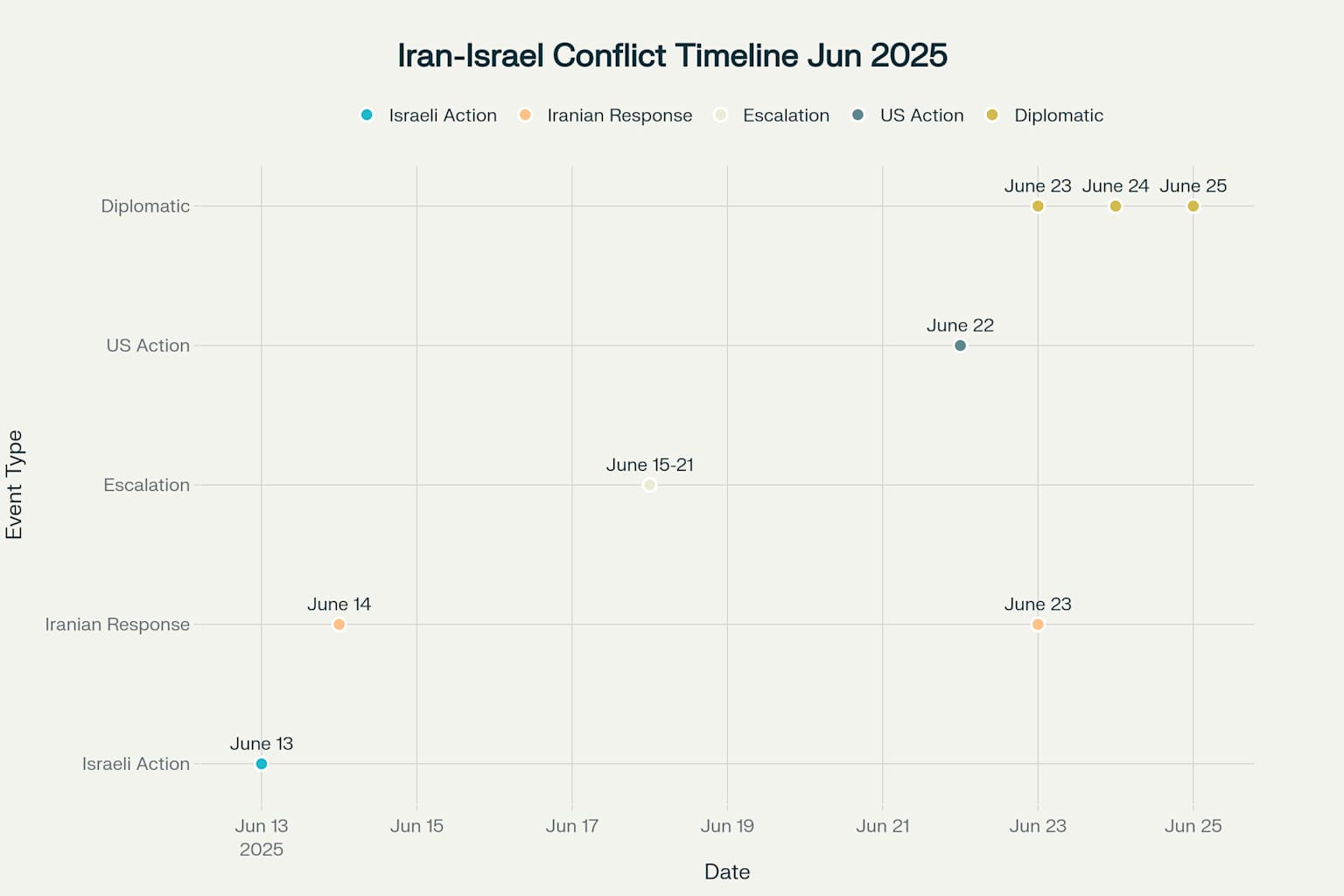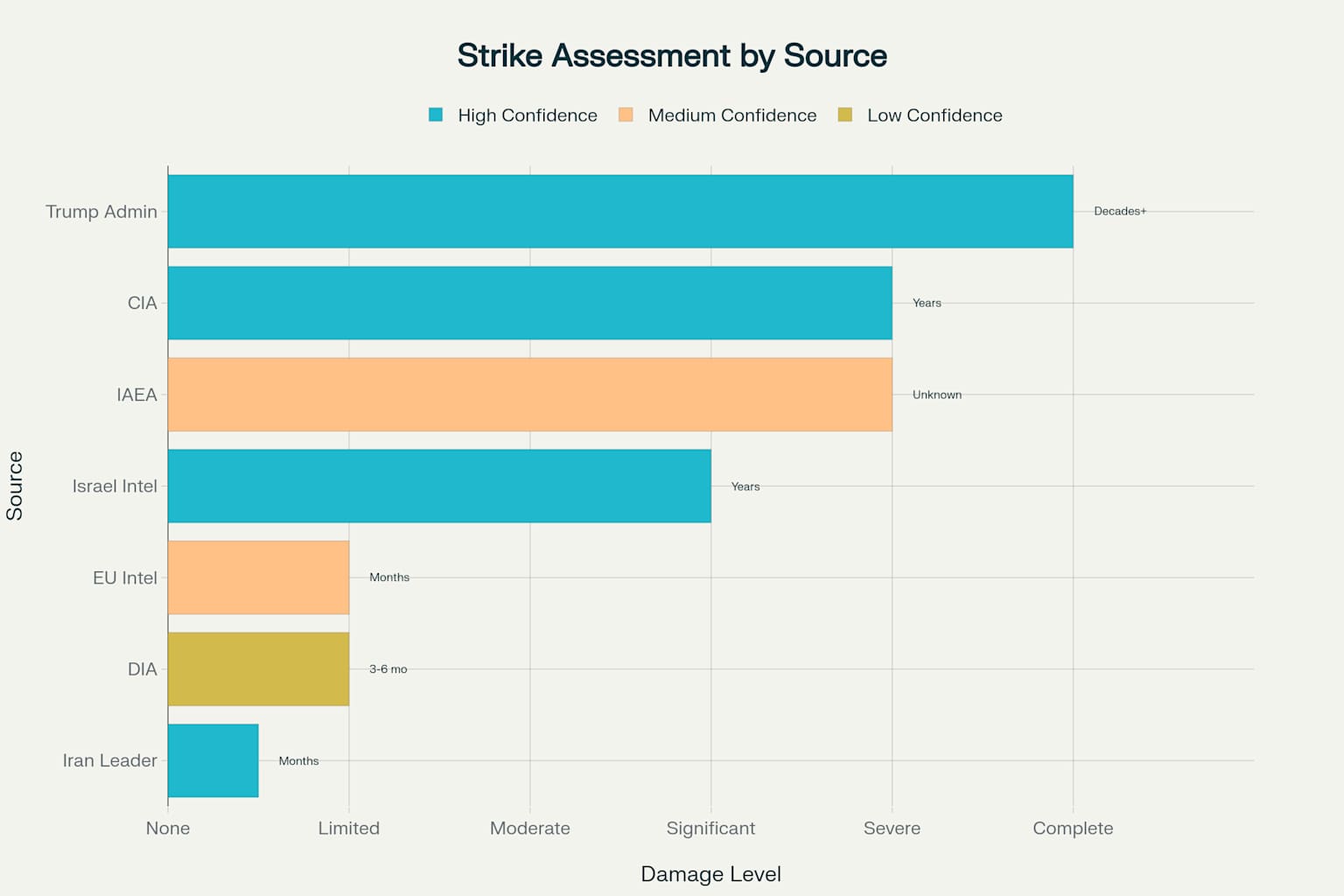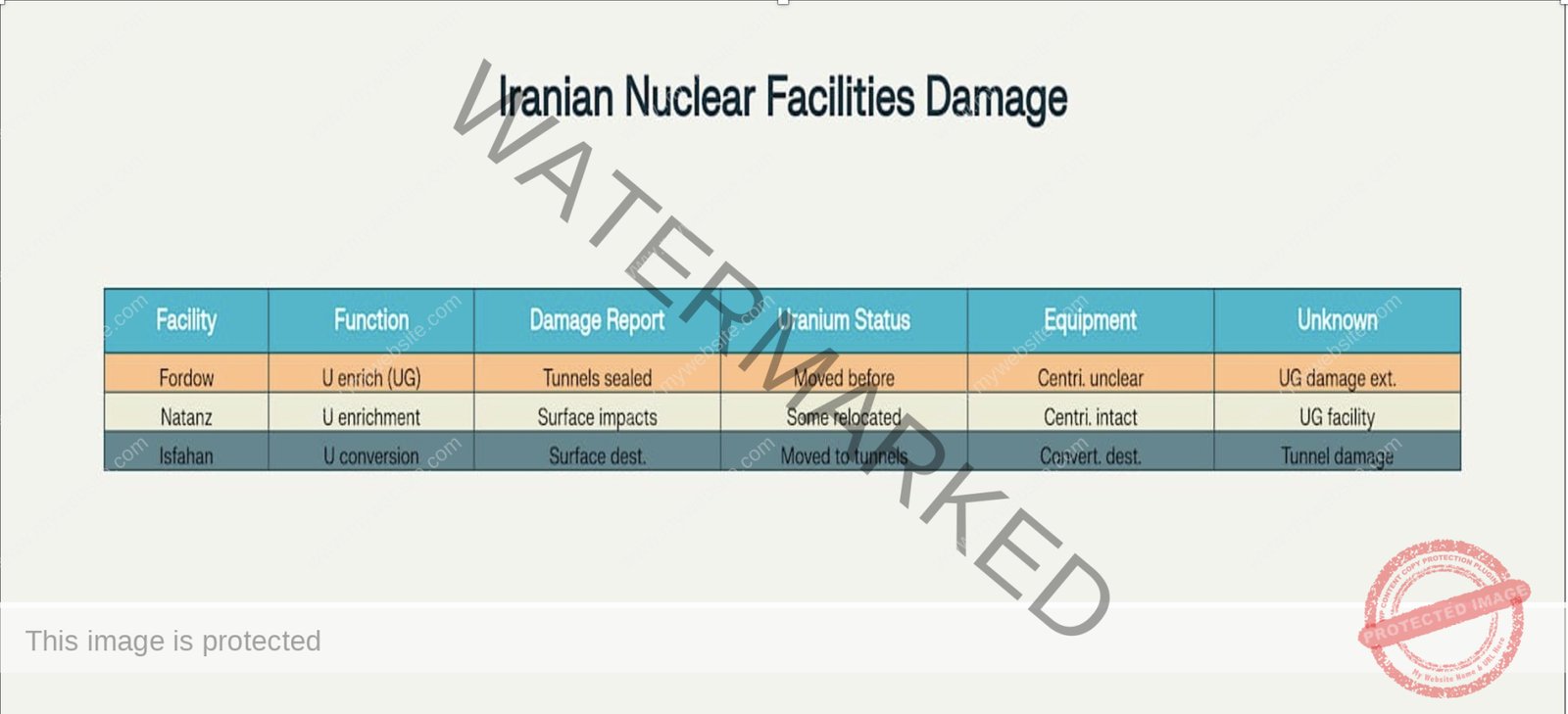by Dr. Hichem Karoui
GEW Assessment Report
Donald Trump asserts that the strike against Iranian nuclear facilities has achieved its objectives, while Iran’s Supreme Leader insists that the Americans and Israelis have failed to achieve their goals in striking the nuclear facilities, and that Iran will not surrender or give up its right to use nuclear energy.
In the United States itself, media reports based on information leaked from the Pentagon indicate that the US strike failed to achieve its objectives and that Iran still retains its uranium enrichment capabilities.
So what exactly happened? Who should we believe? And what information do they not want people to know?
The Battle Over Truth: Analyzing Conflicting Narratives on US Strikes Against Iranian Nuclear Facilities
The June 2025 US military strikes on Iranian nuclear facilities have sparked an unprecedented battle over the narrative, with dramatically conflicting assessments emerging from the highest levels of government, intelligence agencies, and international observers. This controversy reveals deep tensions within the US intelligence community, the politicization of classified assessments, and fundamental questions about what actually transpired during Operation Midnight Hammer.
What Actually Happened: The 12-Day War and US Intervention
The conflict began on June 13, 2025, when Israel launched surprise attacks on Iranian nuclear and military facilities.
This escalated into what became known as the “12-Day War,” with Iran retaliating through missile barrages against Israel and continued exchanges between the two nations. On June 22, the United States dramatically escalated its involvement by conducting strikes against three Iranian nuclear sites: Fordow, Natanz, and Isfahan.

The US operation, codenamed “Operation Midnight Hammer,” involved B-2 stealth bombers carrying 30,000-pound “bunker buster” bombs (Massive Ordnance Penetrators) and submarine-launched Tomahawk cruise missiles.
The strikes targeted the most heavily fortified elements of Iran’s nuclear infrastructure, with particular focus on the underground Fordow facility built deep within a mountain.
The Conflicting Narratives
Trump Administration Claims
President Trump immediately declared the strikes a complete success, stating that Iran’s nuclear facilities had been “completely and totally obliterated”.
. Defense Secretary Pete Hegseth echoed these claims, asserting that Iran’s nuclear capabilities “have been obliterated”. The White House maintained that the strikes achieved “total obliteration” of Iran’s nuclear enrichment capabilities.
Pentagon Intelligence Assessment
A classified preliminary report from the Defense Intelligence Agency (DIA) contradicted the administration’s claims, concluding that the strikes only set back Iran’s nuclear program by “a few months” rather than years or decades.
The assessment, completed within 24 hours of the strikes and marked with “low confidence,” indicated that while entrance tunnels were sealed, the underground facilities remained largely intact.
Iran’s Response
Iran’s Supreme Leader Ayatollah Ali Khamenei dismissed Trump’s claims as “exaggerated,” asserting that the US strikes “did nothing significant” to Iran’s nuclear facilities.
Iranian officials maintained that their nuclear ambitions would continue and that the country would not surrender its right to nuclear energy.
Intelligence Community Split
The intelligence community itself became divided, with CIA Director John Ratcliffe later stating that “credible intelligence” indicated Iran’s nuclear program had been “severely damaged” and would require “years” to rebuild.
Director of National Intelligence Tulsi Gabbard similarly claimed “new intelligence” confirmed the facilities were “destroyed”.

Analysis of Physical Evidence and Damage Assessment
The three targeted facilities each suffered different types and levels of damage, creating a complex picture that has fueled the conflicting narratives.

Fordow Facility
The underground Fordow uranium enrichment facility, built deep within a mountain, was the primary target.
Intelligence reports confirm that entrance tunnels were sealed and ventilation systems damaged, but the extent of underground damage remains unclear. The International Atomic Energy Agency (IAEA) confirmed that the facility suffered extensive damage, though the full scope cannot be determined due to its underground nature.
Natanz Site
The Natanz facility experienced surface impacts and tunnel entrance damage, but intelligence suggests that many centrifuges remained “largely intact”.
This facility had previously been damaged in earlier attacks, making the additional impact difficult to assess.
Isfahan Complex
Isfahan’s uranium conversion facilities were reportedly “completely destroyed” at the surface level.
. However, underground tunnels at the site were believed to contain stored uranium and may have remained intact.
The Missing Uranium: A Critical Unknown
One of the most significant contested facts involves Iran’s stockpile of highly enriched uranium. Before the strikes, Iran possessed approximately 408 kilograms of uranium enriched to 60% purity—close to weapons-grade levels.
Multiple intelligence sources suggest this material was moved from the targeted facilities before the strikes occurred.
European intelligence assessments indicate that Iran’s uranium stockpile “remains largely intact” and was “distributed to various other locations” prior to the attacks.
However, the White House has denied these claims, with Press Secretary Karoline Leavitt stating there was “no indication” that enriched uranium was moved.
Intelligence Community Politicization and Information Control
The controversy has exposed concerning trends in the politicization of intelligence assessments. The Pentagon launched a criminal investigation into the leak of the DIA report, with Defense Secretary Hegseth characterizing it as an attempt to “make the president look bad”.
The FBI is investigating those responsible for sharing the classified document with media outlets.
In an unprecedented move, the White House announced it would limit intelligence sharing with Congressional members following the leak, specifically reducing information posted on CAPNET, the system used to share classified material with Congress.
. This decision has drawn fierce criticism from Democratic lawmakers, who view it as an attempt to avoid oversight.
.
Congressional briefings on the strikes were delayed multiple times, with the all-Senate briefing postponed from Tuesday to Thursday and House briefings rescheduled to Friday.
. Democrats have characterized these delays as evidence that the administration is withholding critical information.
International and Expert Assessments
The IAEA, the UN’s nuclear watchdog, has provided the most authoritative external assessment. Director General Rafael Grossi stated that the damage was “very, very, very considerable” while stopping short of declaring the program eliminated.
The agency confirmed extensive damage at all three sites but noted that Iran likely moved nuclear material to undisclosed locations.
Nuclear experts have offered varying assessments. David Albright of the Institute for Science and International Security concluded that the attacks “effectively destroyed Iran’s centrifuge enrichment program” but noted that “non-destroyed parts can be used in the future”.
Other experts emphasized that definitive damage assessments remain premature given the underground nature of the facilities.
What Information Remains Hidden
Several critical pieces of information remain classified or contested:
Classified Damage Assessments
The full DIA report has not been made public, with only selected details leaked to media outlets.
The complete intelligence picture, including higher-confidence assessments, remains classified.
Underground Facility Status
The true extent of damage to underground enrichment halls at Fordow and other facilities cannot be determined from satellite imagery alone.
This information would require ground-based intelligence or IAEA inspections.
Location of Nuclear Material
The current whereabouts of Iran’s highly enriched uranium stockpile remains unknown to international monitors.
This represents perhaps the most critical intelligence gap, as the material could be used to quickly reconstitute a weapons program.
Secret Nuclear Facilities
US officials believe Iran maintains undisclosed nuclear facilities that were not targeted in the strikes and remain operational.
The locations and capabilities of these sites represent a significant intelligence unknown.
Assessment of Credibility
Evaluating the competing narratives requires examining the credibility and motivations of different sources:
Political Motivations
The Trump administration has clear political incentives to portray the strikes as completely successful, given the president’s campaign promises and public statements.
The timing of contradictory intelligence assessments and the administration’s response suggests potential politicization of the intelligence process.
Intelligence Community Divisions
The split between the DIA’s preliminary assessment and later statements from CIA and DNI leadership indicates internal disagreement within the intelligence community.
. This division undermines confidence in any single assessment.
.
Iranian Incentives
Iran has obvious reasons to downplay the damage while also needing to acknowledge enough impact to justify its retaliatory actions
. Iranian statements should be viewed with skepticism but may contain elements of truth
.
Independent Verification
The IAEA’s assessment carries the most credibility as an independent international organization, though even their access remains limited
. Nuclear experts’ analyses based on available evidence suggest significant but not total damage
.
Implications and Conclusions
The conflicting narratives surrounding the Iranian nuclear strikes reveal several troubling developments. First, the apparent politicization of intelligence assessments undermines the credibility of US intelligence agencies and could have long-term consequences for national security decision-making
. Second, the restriction of intelligence sharing with Congress represents a concerning erosion of democratic oversight
.
The available evidence suggests the truth lies somewhere between the administration’s claims of “obliteration” and Iran’s assertions of minimal impact
. The strikes likely caused significant damage to Iran’s nuclear infrastructure but did not eliminate its ability to reconstitute the program, particularly given the apparent preservation of highly enriched uranium stockpiles
.
Most critically, the controversy highlights the challenges of conducting effective oversight and maintaining public accountability when classified intelligence becomes a political weapon rather than an objective tool for decision-making
. The long-term implications for US intelligence credibility and democratic governance may ultimately prove more damaging than the immediate military effects of the strikes themselves
.
The question of “who to believe” cannot be definitively answered given the classified nature of much evidence and the clear political motivations of various parties. However, the pattern of delayed briefings, restricted information sharing, and contradictory assessments suggests that the administration’s claims of complete success are likely exaggerated, while the true extent of damage remains genuinely uncertain.


MOST COMMENTED
Analyses & Commentaries / Current Affairs / Geopolitics / GEW Assessment Report / Middle East / The Gulf
The Battle Over Truth: Analyzing Conflicting Narratives on US Strikes Against Iranian Nuclear Facilities
Analyses & Commentaries / Current Affairs / GEW Anti-Fascist Briefs / GEW Intelligence Unit / Gulf / Iran / Israel / Middle East / The Gulf
The Gulf Cooperation Council’s Strategic Dilemma: Real Positions on the Iran-Israel War
Book Release / Fiction / Literature / media / Podcast
Isabelle Richard’s Novel, “The Unwritten Chapter” + Podcast Review
Current Affairs / Geopolitics / Gulf / International Affairs / Iran / Islam / Israel / media / MENA Matters / Middle East / New Release / Our Books / Podcast
The Blackmail Doctrine: Trump, Israel, And The Arab Compliance + PODCAST REVIEW
Book Release / Current Affairs / Geopolitics / MENA Matters
La doctrine du chantage: Trump, Israël et la soumission des États arabes
Analyses & Commentaries / GEW Intelligence Unit / Research Paper
Iran’s Enduring Resilience: Why a Decisive Defeat is Elusive, Even with US Intervention
France / Littérature / media / Nos livres / Podcast
Le cercle restreint (Roman) : Présentation+ Podcast critique